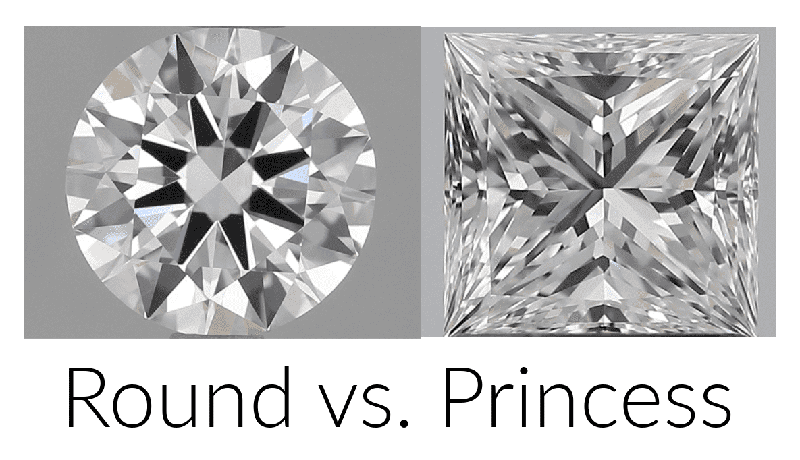Anything For My Princess! A Guide To Princess Cut Diamonds | Rare Carat
Ah, a diamond cut fit for royalty. Okay, maybe that's not what the name is from, but this cut is definitely glamorous and refreshing. Coming in at the second most popular cut style for diamonds, behind the round brilliant. It features great fire and brilliance, and sparkles for days. The square shape creates a modern look that is eye-catching and timeless. Let's dive in and find out more about this beautiful diamond cut!
History

There’s a long progression to this style cut, and there are a few ideas of how the cut actually came about. To begin you need to know that diamonds are found in octahedral form. This is the shape of two pyramids bottom to bottom. Usually the octahedral is cut in half and the diamond cut is blocked out (the way the gem cutters form a rough shape of the style) from there. This can result in a lot of loss of diamond rough, which means it is more expensive, but you get less stone out of it. Since the princess cut is a pyramid shape (square on top, pointed to the bottom) the amount of rough lost in this shape is only about 20%. Other cut styles can range in a loss of 40-50%. So originally, what we now know and love as the princess cut could have been developed due to little loss of diamond rough in the cutting process. However, we may not have gotten the princess cut long ago due to the fact that it requires very symmetrical precise edges to create the modern version we know.
Many believe the commercial start of this style came about in the 1970s by a man named Basil Watermeyer. In 1971 he patented his version named the Barion cut, a moniker named after he and his wife Marion. Imagine a diamond style named Bennifer, or Brangelina. I think there's a market for you, do you? Anywho, Mr. Basil’s version was reminiscent of an emerald and marquise combo cut, so quite different from the one we know today.
As I said, there's some mixed information on where this cut style came about, another adage comes from Arpad Nagy, a diamond cutter from London who created the “profile cut” in 1961, but referred to it as a Princess Cut. Some years later a few lads called Betzalel Ambar, Ygal Perlman and Israel Itzkowitz made the name popular and it stuck. Then in the 1980s the princess cut diamond became quite popular and has stayed that way ever since.
What Makes a Princess, a Princess?

While it may not come from a royal succession (looks like it should though, right?) This is a totally iconic cut you can notice anywhere. The classic princess is a very true square shape, with sharp corners. It touts chevron-shaped pavilion facets, with table facets similar to a round brilliant’s. Facets are the flat parts shaped on the diamond to help light refract back to your eye. A princess cut has 57 facets to help create those flashes of color and light.
One of the best parts of a princess cut diamond is due to the retention of rough (raw diamond). This style only loses about 20%, while other styles may lose almost half. This means a princess is less expensive comparatively. This means you can get a bigger diamond for less money! Win-win! There’s another name for princesses, a square modified brilliant. This comes from the shape of a square, and the facet pattern of a brilliant cut diamond. Shiny, sparkly and square. That's our princess!
Princess Cut vs Round Brilliant

The princess has some similarities to the round brilliant, so what sets them apart, other than corners? As far as refractions go, RB’s reflect 90% of light while princesses only refract 70%. While that's not a huge difference, if you put them side by side you may notice a slight difference. Princess cuts are usually 25-40% less expensive than their round sisters, this is due to the fact of weight retention, so less loss, less expensive.
Since the princess has a square profile, the same carat size may look slightly larger than a round brilliant due to the corners. Those square divas are also less expensive than the RB’s so you can find a larger carat size for less money, usually 25-40% less. Ca-Ching!
Color/Clarity
When searching for your princess cut diamond, there's a few things you want to look out for. Watch for clarity imperfections called inclusions. These are little specs or fractures internally in the diamond. With the amount of refraction going on in this style sometimes that can help cover up some of those spots, but if there is an inclusion right under the table (the flat part on the top) it could be very noticeable. Always move the stone around (whether in a setting or loose) in different lights to see if an inclusion pops up at an angle.
Color refers to the amount of yellow or brown hue to a diamond. While usually, this is not too noticeable (especially in jewelry stores unless you're looking at fancy colored diamonds, you probably won't notice any kind of color to them) the less color a diamond has, the easier light refracts, meaning more sparkle to your stone. If you do find a gem that has a lower clarity grade, setting it in a yellow gold option will make it blend in and not look any different than any other colorless stone.
Finally...
So there’s the low down on Princess Cut Diamonds, I hope you learned a little something to help your search. Now go find your dream diamond fit for a queen! Or technically, a princess!

